Peter Dornauf – 22 February, 2014
The winner itself reflects this socio-political focus that bedevils New Zealand art. I'm not sure about you but I have a slight antipathy for works that have a topical flavour. So the prize ($20,000) going to a piece about climate change: We Asked for Signs, by Stephen Ellis, was not a good sign, at least for me.
Selected finalists
The New Zealand Painting and Printmaking Award, 2014
Judged by Courtney Johnston
14 February - 27 February 2014
It’s that time again folks where we thank the sponsors, which range from the principal one, down through a descending hierarchy of contributors: gold, silver and bronze. We seem to be at the Olympics of art patronage here, a contest that mimics the show itself. Yes, it’s the annual New Zealand Painting and Printmaking Award on in Hamilton, this year judged by Courtney Johnston, director of the Dowse.
Forty six works were selected from two hundred and sixty one submitted, which because of the nature of the beast, are limited to paintings and print works. This leaves out a lot, but such reductionism also helps to concentrate the mind. Most judges these days plump for a judicious spread that includes a wide variety of elements, which may or may not be a good thing. It does throw up a smorgasbord of material, not a bad thing and dampens down any nascent criticism of curatorial or personal bias. What that does at least is present a plethora of current practice in terms of both subject and treatment, always an instructive encounter.
This time I thought I would play the stats game and focus on subject matter by simply counting up the various themes engaged by the participants in order to discover what it was that was taxing the minds of artists these days. Having done so, the subject of nature in various guises took out the lion’s share. There were works to do with New Zealand as Pacific paradise, climate change figured, the preservation of the Brazilian grasslands was present, patterns made by the sun’s movement were included as well as a couple of others to do with our relationship with nature. After that came three or four separate pieces that dealt with the perennial subject of colonization. This was matched with several works that touched on matters to do with social media - television, advertisement and movie industry. There were a few that covered topics to do with human tragedy and trauma - dementia, the ordeal of ‘restructure’ in the work force and the vulnerability of the human mind. Sexual politics also got a quick look in.
In sum, the usual fare one finds in New Zealand art practice plus a bit of abstraction thrown in for good measure. In other words, social issues, what might be described as second order stuff that generally gets pumped out of most New Zealand art stables today. It’s a commentary on ourselves as much as anything else, although we don’t know what the other two hundred and fourteen that were omitted were about. My bet is they were probably much the same.
The winner itself reflects this socio-political focus that bedevils New Zealand art. I’m not sure about you but I have a slight antipathy for works that have a topical flavour. So the prize ($20,000) going to a piece about climate change: We Asked for Signs, by Stephen Ellis, was not a good sign, at least for me. What made it worse was the finger wagging that went with it. If I want to be preached at, I’ll go to church. What such practice assumes is that any graphic instruction is going to make some real difference, some significant change in the universe.
The blurb that went with it, which in part reads that the imagery suggests “the futility of repair and reconstruction in the face of colossal climate change”, didn’t improve matters. Just what we need in our hour of need, a roll over and die disposition. Hello defeatism.
Having said all that, I can see why the judge picked it out to carry the day. Its technical audacity is quite arresting, particularly when one discovers that this moderately large creation was made with a humble ballpoint pen and correction fluid on paper. Made up of millions of dots, it is a wonder of craft - especially given that the piece is limited to monochrome.
Rei Haman in the seventies used the same trick to create slightly cheesy images of New Zealand birds and the like, but here the technique is managed for more serious ends and its virtuosity is considerable. The tonal variation is masterful and the whole exudes a clever film noir quality. The process involved in the creation of the final piece began with the making of a maquette of the subject. The 3D object was then photographed followed by a digital reconfiguration of the image to find a final compositional format before the more manual process of dot work began. Much work involved.
Others in the show worth special mentioning include someone going by the name of The Vivian whose digital photographic print, She Held Her Cigarette Like a Swan, was immediately striking. It took Lichtenstein’s Ben Day dots and pushed them to another level. For me this was a contender as was Carole Shepheard’s Print Gymnastics, involving an adroit play between figure and ground, abstract and figurative elements, print and ‘painting’, using collograph, screen-print, flocking and gold leaf.
I enjoyed the inclusion of fabric material in Kelly Pretty’s, Drawing 69, The Reunion. John Pusateri’s Gut Instinct V11 deserves mention while The Crossing by Sarah Ziessen stopped me for a second look, as did Donna Turtle Sarten’s Lost in Wonderland, a photograph of the artist’s mother suffering from dementia. This is a moving and disturbing image made all the more poignant given that the setting involved takes in a long corridor trailing off behind the woman who is ‘lost’ in her own home. The high angle view of the shot making the figure look smaller, reminds us of Alice lost in her own surreal word.
All in all something for everyone and something that provides a glimpse of what artists - young and established - are up to these days.
Peter Dornauf
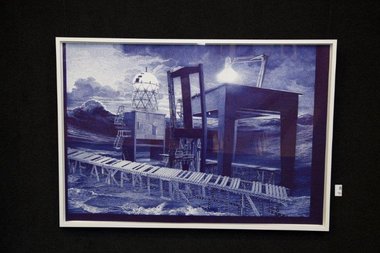
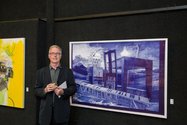
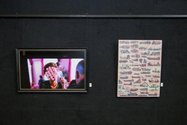
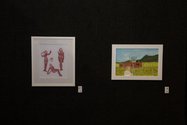
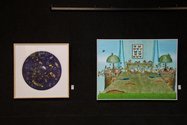
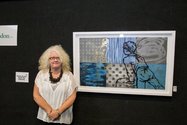
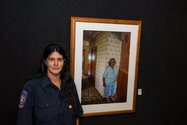
 Advertising in this column
Advertising in this column Two Rooms presents a program of residencies and projects
Two Rooms presents a program of residencies and projects



This Discussion has 0 comments.
Comment
Participate
Register to Participate.
Sign in
Sign in to an existing account.